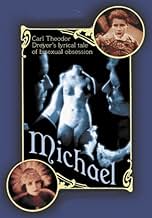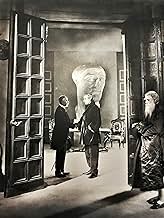IMDb RATING
7.1/10
2.1K
YOUR RATING
Triangle story: painter, his young male model, unscrupulous princess.Triangle story: painter, his young male model, unscrupulous princess.Triangle story: painter, his young male model, unscrupulous princess.
Mady Christians
- Frau
- (uncredited)
- Director
- Writers
- All cast & crew
- Production, box office & more at IMDbPro
Storyline
Did you know
- TriviaGrete Mosheim's debut.
- GoofsWhen the painter Claude Zoret is talking to Mikael's creditor he switches from standing up to sitting down back to standing up between shots.
- Quotes
[first lines]
Motto (titlecard): Motto: Now I can die in peace for I have known a great love.
- Alternate versionsIn 2004, Kino International Corporation copyrighted a version with a piano score compiled and performed by Neal Kurz. It was produced for video by David Shepard and runs 86 minutes.
- ConnectionsFeatured in Carl Th. Dreyer (1966)
Featured review
This is a German silent film. Obviously it would take Hollywood at least half a century longer to get anywhere near this subject in such a natural manner, and in many ways, still to this day it has not produced anything to compare to this sensitive portrayal about an aging master painter (Benjamin Christensen) who takes a male model/hustler and aspiring painter (Walter Slezak) under his protection. Soon however, their relationship begins to change when both men encounter the gorgeous Princess Zamikoff (Nora Gregor) who is supposed to be ruined but happens to be on her way to the opera when she makes a visit to commission her portrait and comes back later dressed to kill, with an outfit that must have cost a fortune and that we must assume she did not pay for herself.
This clearly indicates that the Princess is a professional gold-digger-hustler, and though not a courtesan, certainly someone in the related business of living by her charms, with enough savoir-faire to be part of the trade. This is an important character trait of the woman in the triangle, because it makes perfect sense within the context of co-dependent sex relationships: She is hustling Michael as much as Michael hustles the painter and that is the actual mechanism of the relationship.
This is an excellent Dreyer film, not quite popular or well know here for the subject matter being an early example of a homosexual relationship. Most importantly, both of the men involved are portrayed as virile and masculine, there is no cross dressing, hilarity of character or the usual histrionics that was the sole, monolithic identity of gay men in an American cultural context until the arrival of "Brokeback Mountain". Some viewers may be in such denial as to the existence of a gay life for "straight-looking" men that they may debate that the film is not about homosexuality, as one of the men gets involved in a heterosexual relationship, and I completely disagree with this stance, as most gay men are actually like the ones in this movie and not like the more flamboyant part of the group that naturally steal the limelight and distort the statistical truth.
The complexities and variety of homosexual experience either in gay men or women have always posed a challenge on the imagination and intelligence of society, but we can not deny that there was much more than simple friendship between these two men, if only because there had to be a valid reason for Michael to accept money gifts and also steal as much from the painter. However, because there were an infinite amount of choices by means of which this could have been clarified, and certainly there are earlier movies that showed it was done in Germany ("Different from the Others" for example, 1919) I see this important detail as an error in character development and that's why I have given it an 8 ranking.
The cinematography by Rudolph Mate and Karl Freund is exquisitely handled. All details of decor, furnishing and costume are lavish and within the cultural context of the period. We see the subtle transitioning from Art Nouveau to early Deco in the differences between the older painter's home and the younger hustler's apartment.
The character of the suffering, self-sacrificing older lover in a relationship is a very 19th Century attitude and romantic posturing that reached a climax with Dumas famous "Dame aux Camelias" that became the "Camille" of the stage and movie adaptations as well as Verdi's "Traviata" in opera. Christensen's devoted love for Michael, even when he discovers his thievery and baseness is part of that socio-cultural heritage, the extreme of which had been Oscar Wilde in the generation before the one in this movie, which went one step further in the 'sacrifice' to self destruction. Within this context the painter's plight is totally believable and acceptable, but aside from the artistic beauty of the film itself, the important message that comes through is the validity and truth of that love.
This clearly indicates that the Princess is a professional gold-digger-hustler, and though not a courtesan, certainly someone in the related business of living by her charms, with enough savoir-faire to be part of the trade. This is an important character trait of the woman in the triangle, because it makes perfect sense within the context of co-dependent sex relationships: She is hustling Michael as much as Michael hustles the painter and that is the actual mechanism of the relationship.
This is an excellent Dreyer film, not quite popular or well know here for the subject matter being an early example of a homosexual relationship. Most importantly, both of the men involved are portrayed as virile and masculine, there is no cross dressing, hilarity of character or the usual histrionics that was the sole, monolithic identity of gay men in an American cultural context until the arrival of "Brokeback Mountain". Some viewers may be in such denial as to the existence of a gay life for "straight-looking" men that they may debate that the film is not about homosexuality, as one of the men gets involved in a heterosexual relationship, and I completely disagree with this stance, as most gay men are actually like the ones in this movie and not like the more flamboyant part of the group that naturally steal the limelight and distort the statistical truth.
The complexities and variety of homosexual experience either in gay men or women have always posed a challenge on the imagination and intelligence of society, but we can not deny that there was much more than simple friendship between these two men, if only because there had to be a valid reason for Michael to accept money gifts and also steal as much from the painter. However, because there were an infinite amount of choices by means of which this could have been clarified, and certainly there are earlier movies that showed it was done in Germany ("Different from the Others" for example, 1919) I see this important detail as an error in character development and that's why I have given it an 8 ranking.
The cinematography by Rudolph Mate and Karl Freund is exquisitely handled. All details of decor, furnishing and costume are lavish and within the cultural context of the period. We see the subtle transitioning from Art Nouveau to early Deco in the differences between the older painter's home and the younger hustler's apartment.
The character of the suffering, self-sacrificing older lover in a relationship is a very 19th Century attitude and romantic posturing that reached a climax with Dumas famous "Dame aux Camelias" that became the "Camille" of the stage and movie adaptations as well as Verdi's "Traviata" in opera. Christensen's devoted love for Michael, even when he discovers his thievery and baseness is part of that socio-cultural heritage, the extreme of which had been Oscar Wilde in the generation before the one in this movie, which went one step further in the 'sacrifice' to self destruction. Within this context the painter's plight is totally believable and acceptable, but aside from the artistic beauty of the film itself, the important message that comes through is the validity and truth of that love.
- How long is Michael?Powered by Alexa
Details
- Runtime1 hour 33 minutes
- Sound mix
- Aspect ratio
- 1.33 : 1
Contribute to this page
Suggest an edit or add missing content































